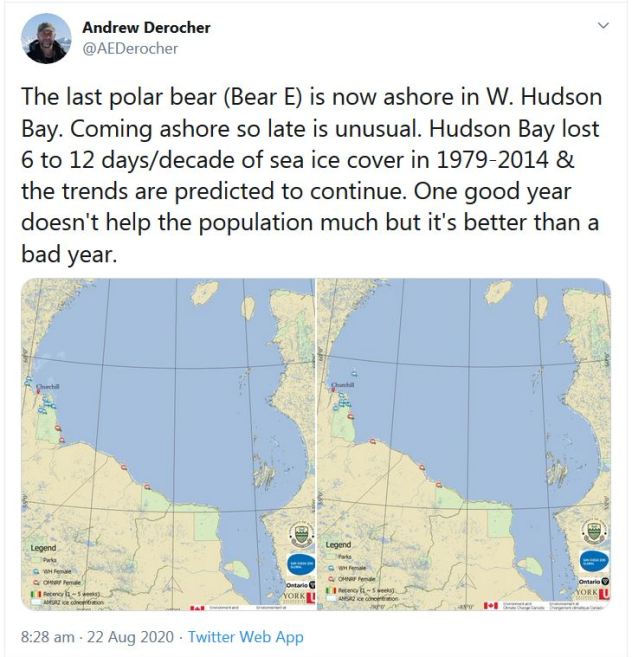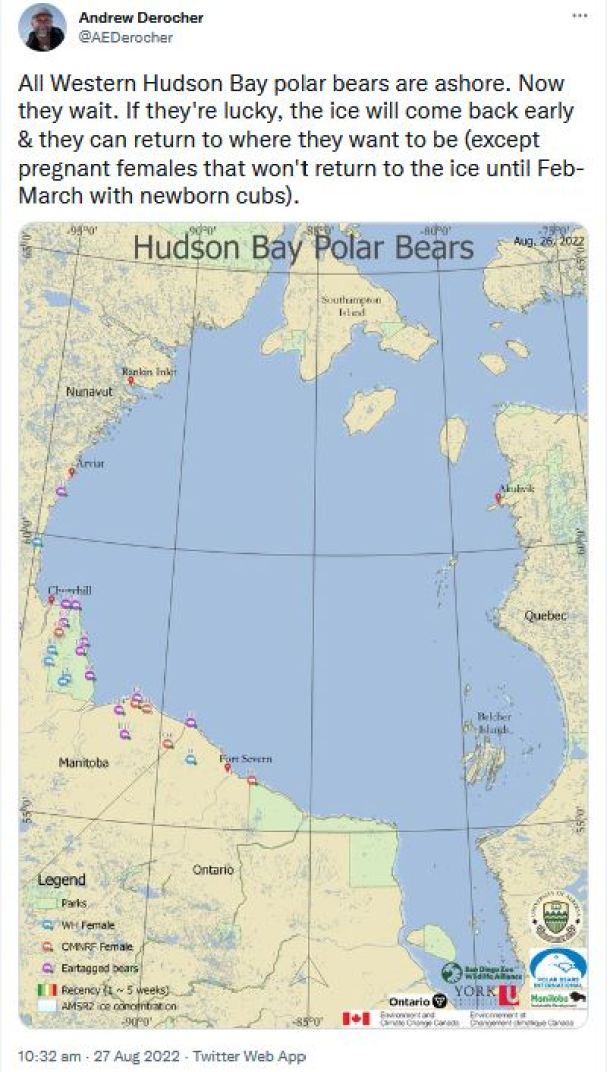Dr. Susan Crockford
According to Andrew Derocher this morning, the last of his teams’ tagged polar bears have come ashore in Western Hudson Bay, in the last week of August. That makes two years out of the last three when the tagged WH bears came ashore as late, or later than, they had done in 2009 (a very cold year when they were onshore by about 20/21 August), something Derocher failed to mention during a CBC Radio interview also published today.
Don’t forget: this is the subpopulation that polar bear specialists use to model the future of all bears, everywhere in the Arctic but only use stale data from the 2000s because including more recent information would give a much more optimistic picture.

Meanwhile, no further reports from Churchill about problem bears: the last one issued was for the first week in August. Time will tell at freeze-up whether this will be yet another very good year for Western Hudson Bay bears.
Last bears to leave the ice
2020, at 22 August with a map dated 21 August (on the left) compared to 14 August the same year (note the emphasis on ‘unusual’ and the repetition of trend statistics up to 2014 — rather meaningless six years later — as is the reminder of a prediction that has failed to materialize, on top of the notation that this was only “one good year”):
2022, at 27 August with a map dated 26 August (no mention of “one good year doesen’t help much” or “coming ashore so late is unusual”, or that this date is even later than 2020):
Arctic sea ice conditions last week August
2020, 25 August [4.7mkm2]:

2022, 26 August [5.4mkm2]



I’m still trying to figure out why polar bears are such good swimmers.
You’d never expect that attribute by looking at them.
Due diligence: I’m pro-seals and anti-polar bears
I expect by that token that you could well be pro-flies and anti-spiders…
Maybe they are good swimmers because they practice a lot. I doubt if they catch seals by swimming after them, though.
Much the same reason for why the Inuit/Eskimos are excellent kayak builders and kayakers, and why they are good Whalers.
I thought similar re Newfoundland hounds, thinking ‘who’d want one of them?’ 1) big dog = big clean up 2) gotta be a pain to dry after wet weather, etc. Was put right by an owner of same. Yes, big craps but quick drying, well insulated (or summat) and webbed paws a la polar bear. Used on trawlers for rescue, so l was told.
Dr. Susan continues the useful Reality Check, showing the CAGW poster boy, the polar bear, is doing very well and not cooperating with the “consensus”. I remember the film, shown on American Sportsman, of archery hunter Fred Bear stalking a polar bear, only to lower his bow and back off. Fred later said it was the most fear he had ever experienced hunting, including lions and other apex predators. Sorry, Fred participated in the over-hunting of polar bears, but they are not the cuddly mascots portrayed by the media.
Another Polar Bear story. Aren’t they extinct?
The stories or the bears Simon? I think that the stories are thriving as much as the bears. Incredible that the penny hasn’t dropped for the authors despite year after year of contradictory evidence.
There is none so blind as those who will not see.
Getting more rare every year. Of the 5000 bears remaining in 1960, there are only 37000 left.
Due to the ice melting due to globular warning….
“Hudson Bay lost 6-12 days per decade of sea ice cover 1979 – 2014 & the trends are expected to continue”.
Does this Derocher chap have a problem with maths and/or statistics? A 35 year trend appears to have been broken for 8 years but it’s still “expected to continue”? Clearly I need to go back to school.
Ian, you can’t go back to school because you never would get past the “woke” interviews, designed to identify deniers. Just saying.
Can some provide a chart of Hudson Bay ice coverage? I can’t seem to picture what a 6-12 days per decade trend in sea ice cove from 1979 to 2014 looks like. Does that mean that sea ice cove is 21 to 42 days less in 2014 than in 1979? Extending it to 2022 would be very helpful too.
How the Hell does Derocher know the trend will continue? Does he have a crystal ball?
I expect he’s an ‘expert’….
You do not need data to become an expert, you declare it.
Those are a couple of fine-looking polar bears in the first photo. Looks like it will be a tough year to get pictures of starving poley bears.
No All the old geriatric farts of polar bears will all get emaciated and die. like people ‘cept that we promote them to the Whitehouse first
Ouch! But true.
No, Alastair. When the polar bears get old and creaky, they retire to Florida just like everyone else. The photographers are in the wrong place to get pictures of old emaciated polar bears.
I note that one of them is on land and has a mouthful of something that is not seal. An impossibility according to the Derocher and PBI.
Polar Bears are Still bears: Eat anything but a rock.
Bears take ‘omnivore’ seriously.
The Southern Hemisphere is going through dramatic cooling thanks to Tonga and this will impact the Northern Hemisphere as well over time. Greenland just added 7 gigatons of ice to end the melt season, which if my calculations are correct, is a lot. November to March is going to be a winter to remember for the NH and the polar bears are going to love it. Best of luck to all those windmills running full tilt to keep the lights on.
“Greenland just added 7 gigatons of ice…”
I can hear them now: “It’ll never be enough…”
Did Greenland add that 7 gigatons to her hips?
Winter is gonna be the same as usual,some warmer some colder days.
NW Passage open this year…
Yep, the NW passage is so open that National Geographic is only charging $40,000.00 for a 3 week cruise in 2023.
I guess they are serving lobster and filet with Foie Gras and Beluga caviar at every meal.
Since we know there is no danger of ice impact since the passage is OPEN, they must be using a standard cruise ship. There must be some reason for the high price, right griff?
Non sequitur alert!
When you get to Churchill, read the warning / welcome sign.